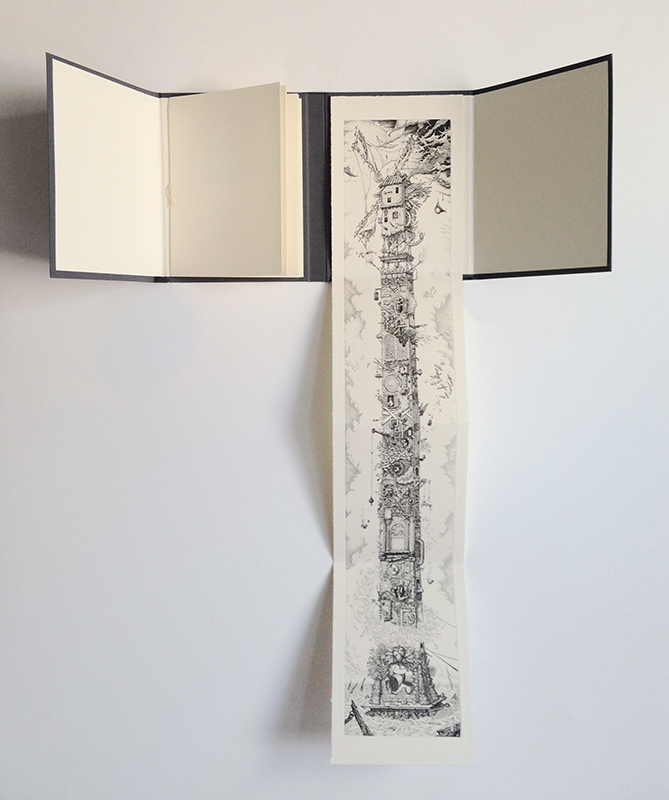Obeliscolychny is an etching from 2013 by American printmaker David Avery. It is presented within a bound book and unfolds to its full length. It was printed by the artist on Magnani Revere Silk Ivory paper at his San Francisco studio. While the etching is unsigned, the colophon is pencil signed by the artist and editioned 9/20. The texts, excerpts from the works of François Rabelais and Alfred Jarry, were typeset and printed by Jonathan Clark at Artichoke Press in Mountain View, California. Obeliscolychny measures 27-7/8 x 4-5/8 inches and the book measures 8-1/2 x 6-3/4 x 3/4 inches.
David Avery wrote the following: “Obeliscolychny?” you may be tempted to ask. And with good reason. Arguably one of the most obscure and rarely used terms to be found in literature (or anywhere else), but with, perhaps, undue influence relative to its obscurity, obeliscolychny was invented/appropriated by Francois Rabelais (@1483-1553) and used in books IV and V of his sprawling tales of Gargantua and Pantagruel. Possibly derived from Aristotle’s Politics, which used it to describe a kind of spit used by soldiers to hang lamps on as a metaphor for…well, something or other, it acquired a meaning somewhere along the way of a lighthouse in the form of an obelisk. Centuries later, Alfred Jarry (1873-1907), poet, playwright, critic, puppeteer, and subverter of objective reality, discovered the word while reading Rabelais and became enamored with it, using it (pataphysically, of course) in several of his novels. That these works tend to be as convoluted and recondite as the origins of obeliscolychny itself was part of what provided grist for the mill of this project. In picking the texts for this project, I tried to include every literary reference that either included or alluded to this recondite word, making for a very thin book (six in all). Of course, in subsequent years, I discovered two more—George Perec’s parody in Life A User’s Manual, and another in Jarry’s Caesar-Antichrist. Perhaps there are more…
David Avery, born 4 February 1952, has been creating finely detailed black and white etchings in San Francisco for over thirty years. Originally trained as a classical musician, Avery discovered etching almost by accident in a class at a local community college. After learning the basic techniques, he intently pursued his own course of discovery, being essentially self-taught. Over the years, he has developed an exceptional technique and has created a remarkable body of finely wrought miniature etchings and drypoints. He prefers printing in black and white finding the subtleties and tonalities most capable of creating the psychological mood that allows his work to be effective.
Avery has a long and active exhibition history and his prints have earned him numerous awards and honors. He has been a member of and exhibited with the California Society of Printmakers, the Washington Printmakers, and the Society of American Graphic Artists. His works are represented in the collections of the Fogg Museum, Harvard University, Cambridge, Massachusetts; the Turner Print Museum, California State University, Chico, California; the Nelson-Atkins Museum of Art, Kansas City, Missouri; the New York Public Library, New York; the Fine Arts Museums of San Francisco, California; Stanford University Library, Special Collections, Stanford, California; and the Folger Shakespeare Library and the Library of Congress, Washington, D.C.



